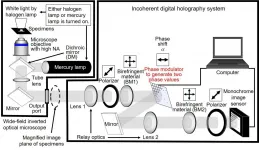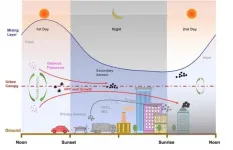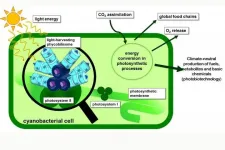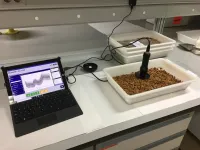INFORMATION:
BioNTech-Pfizer mRNA vaccine largely effective against UK variant, Sera from 40 patients show
2021-01-29
(Press-News.org) In a study evaluating the BioNTech-Pfizer COVID-19 vaccine's ability to neutralize the B.1.1.7 ("UK") viral variant, researchers found no loss of immune protection compared to that against the original Wuhan reference strain. Their analysis was based on blood samples from 40 people who had received the BioNTech-Pfizer COVID-19 vaccine during clinical trials. The authors conclude their results show it is "unlikely that the UK variant virus will escape ... protection" as mediated by this vaccine. In September 2020, the SARS-CoV-2 lineage B.1.1.7 was discovered in the United Kingdom. It subsequently increased in prevalence, showed enhanced transmissibility, and spread to other continents. The B.1.1.7 variant has a series of mutations in its spike (S) protein, which it uses to gain entry to host cells. Whether a virus with the large number of mutations found in the spike protein of lineage B.1.1.7 could be neutralized by the blood sera from people who had received the BioNTech-Pfizer COVID-19 vaccine is an important question. To investigate, Alexander Muik, Ugur Sahin and colleagues generated SARS-CoV-2-S pseudoviruses bearing either the Wuhan reference strain or the B.1.1.7 lineage spike protein. They tested these viruses with blood sera of 40 people who had received the BioNTech-Pfizer COVID-19 vaccine following the recommended regimen of two doses administered 21 days apart. The sera had slightly reduced but largely preserved neutralizing titers against the B.1.1.7 lineage pseudovirus, they found. This suggests the UK variant won't "escape" vaccine-mediated protection, as provided by this vaccine. The authors note that the non-replicating pseudovirus system they used may be a potential limitation of the study. They also conclude: "Although sustained neutralization of the current B.1.1.7 variant is reassuring, preparation for potential COVID-19 vaccine strain change is prudent. Adaptation of the vaccine to a new virus strain would be facilitated by the flexibility of mRNA-based vaccine technology."
ELSE PRESS RELEASES FROM THIS DATE:
High-speed holographic fluorescence microscopy system with submicron resolution
2021-01-29
[Abstract]
The National Institute of Information and Communications Technology (NICT), Tohoku University, Toin University of Yokohama, and Japan Science and Technology Agency (JST) have succeeded in developing a scanless high-speed holographic fluorescence microscopy system with submicron resolution for a 3D space. The system is based on digital holography. The developed microscopy system has an algorithm to acquire 3D information of fluorescent objects toward scanless 3D measurement in less than 1 millisecond. Scanless 3D sensing with submicron resolution and color-multiplexed holographic fluorescence imaging have been demonstrated using the algorithm. The microscopy system will be further developed to achieve holographic 3D motion-picture sensing of specimens ...
Biobased anti-thrombosis agent
2021-01-29
Thrombosis, the clogging of blood vessels, is a major cause of heart attacks and embolism. Scientists have now engineered the first inhibitors of thrombin, a protease promoting thrombosis, that is three-fold efficient. In a study published in the journal Angewandte Chemie, the authors demonstrate that attacking three sites of the thrombin molecule is more efficient than attacking only two sites, which is the mode of action of many natural agents.
Soon after an injury, thrombin appears at the site of the wound, promoting platelet coagulation and fibrin development to clog the wound and grow new tissue. Unfortunately, inside blood ...
How lipids distribute proteins within cells
2021-01-29
An international team of scientists, coordinated by the Seville Institute of Biomedicine (IBiS) and the University of Seville has solved one of the hitherto unresolved enigmas of basic biology: how exactly do lipids distribute proteins within a cell? To do this, they used a new, completely innovative microscopy technology, which they applied to "mutant" cells they designed in their laboratory.
This discovery represents a major advance in understanding how proteins are distributed in cells to perform their vital functions, and could open the door to understanding the causes of diseases associated with failures in protein distribution at the ...
Yangtze River observational system to improve East Asian rainy season forecasting
2021-01-29
Researchers have completed the first ever multi-level hydrological tracking of the Yangtze River from the ground, air and space in order to investigate the properties of cloud formation during the mei-yu--an intense rainy season that forms part of East Asia's summer monsoon. The effort should permit greater understanding of the mei-yu precipitation process and thus enable much more accurate forecasts of this key meteorological phenomenon in the region.
The mei-yu, also known as the "Plum Rain", is a period of severe, concentrated rainfall that lasts for up to two months during the late ...
Schoolchildren are learning about health through football (soccer)
2021-01-29
Knowledge about health is a cornerstone in a child's development of physical and psychosocial health.
Since 2016, around 25,000 pupils in years 4-6 in 86 of Denmark's municipalities have taken part in the project "11 for Health in Denmark", an 11-week exercise and health education programme offered to all schools in a collaboration between the University of Southern Denmark and the Danish Football Association.
More than 3,000 of these pupils completed questionnaires before and after the programme aimed at determining their knowledge about health and understanding their experience of the 11-week programme.
An increase of 10 percentage ...
Local emissions amplify regional haze and particle growth
2021-01-29
New particle formation (NPF) is a major source of aerosol particles in the global atmosphere. In polluted megacities, such as Beijing, the role of new particle formation events and their contribution to haze formation through subsequent growth is still unclear.
To improve the understanding of the sources, meteorological conditions, and chemistry behind air pollution, the research teams led by Prof. Yele Sun with the Institute of Atmospheric Physics at the Chinese Academy of Sciences and Prof. Markku Kulmala with the University of Helsinki performed simultaneous measurements ...
Production of 'post-lithium-ion batteries' requires new skills
2021-01-29
Research on manufacturing battery cells is gaining momentum - and there is a strong need, considering the future demand for energy storage: For the year 2030, global production of rechargeable batteries will double from today's 750 gigawatt hours (GWh) per year to 1,500 GWh. A recently published review article in the magazine "Nature Energy" on cell production of various battery types suggests that the currently established lithium-ion batteries (LIB) dominate the market of rechargeable high-energy batteries in the coming years. Alternative battery technologies, ...
Past river activity in northern Africa reveals multiple Sahara greenings
2021-01-29
Large parts of today's Sahara Desert were green thousands of years ago. Prehistoric engravings of giraffes and crocodiles testify to this, as does a stone-age cave painting in the desert that even shows swimming humans. However, these illustrations only provide a rough picture of the living conditions. Recently, more detailed insights have been gained from sediment cores extracted from the Mediterranean Sea off the coast of Libya. An international research team examined these cores and discovered that the layers of the seafloor tell the story of major environmental changes in North Africa over ...
A small protein in bacteria overlooked up to now
2021-01-29
The biological process of photosynthesis is found at the beginning of nearly all food chains. It produces oxygen to breathe and provides the energetic foundation for using biotechnological processes to synthesize biofuels and chemical feedstock. Therefore, researchers are particularly interested in rapidly growing cyanobacteria. These organisms use light as an energy source and can carry out photosynthesis, similar to plants. However, the required photosynthetic protein complexes bind many nutrients. Vanessa Krauspe and Prof. Dr. Wolfgang Hess from the working group for Genetics & Experimental Bioinformatics of the Faculty of Biology of ...
New technology to detect bitter almonds in real time
2021-01-29
Who hasn't at some point been chewing on an almond and tasted an unpleasant and unexpected aftertaste that has nothing to do with the taste we are used to from one of the most consumed nuts in the world? The culprit has a name: amygdalin, a diglucoside that, when in contact with enzymes present in saliva, breaks down into glucose, benzaldehyde (the cause of the bitter taste) and hydrogen cyanide.
To reduce this unpleasant 'surprise', the Farming Systems Engineering (AGR-128) and Food Technology (AGR-193) research groups at the University of Cordoba's School of Agricultural and Forestry Engineering, ...







